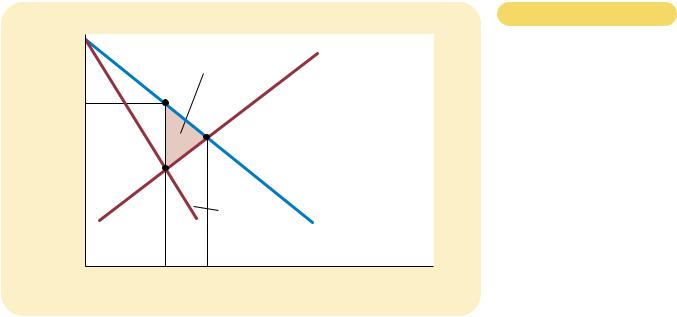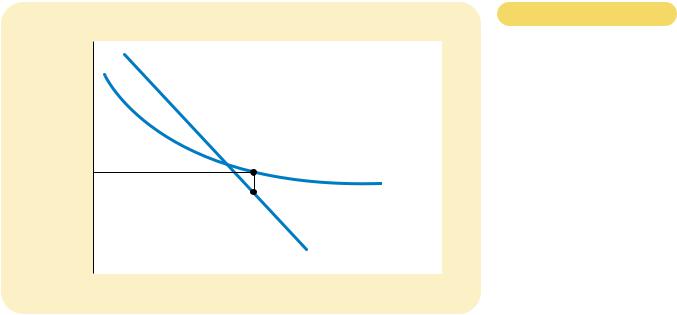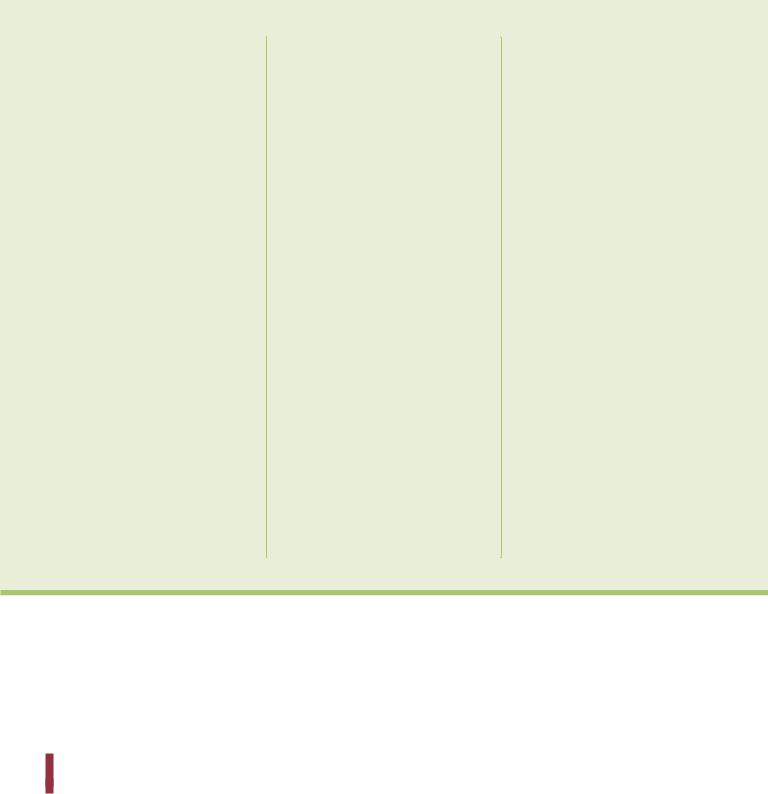
Mankiw Principles of Economics (3rd ed)
.pdf


330 |
PART FIVE FIRM BEHAVIOR AND THE ORGANIZATION OF INDUSTRY |
THE MONOPOLY’S PROFIT : A SOCIAL COST?
It is tempting to decry monopolies for “profiteering” at the expense of the public. And, indeed, a monopoly firm does earn a higher profit by virtue of its market power. According to the economic analysis of monopoly, however, the firm’s profit is not in itself necessarily a problem for society.
Welfare in a monopolized market, like all markets, includes the welfare of both consumers and producers. Whenever a consumer pays an extra dollar to a producer because of a monopoly price, the consumer is worse off by a dollar, and the producer is better off by the same amount. This transfer from the consumers of the good to the owners of the monopoly does not affect the market’s total surplus—the sum of consumer and producer surplus. In other words, the monopoly profit itself does not represent a shrinkage in the size of the economic pie; it merely represents a bigger slice for producers and a smaller slice for consumers. Unless consumers are for some reason more deserving than producers—a judgment that goes beyond the realm of economic efficiency—the monopoly profit is not a social problem.
The problem in a monopolized market arises because the firm produces and sells a quantity of output below the level that maximizes total surplus. The deadweight loss measures how much the economic pie shrinks as a result. This inefficiency is connected to the monopoly’s high price: Consumers buy fewer units when the firm raises its price above marginal cost. But keep in mind that the profit earned on the units that continue to be sold is not the problem. The problem stems from the inefficiently low quantity of output. Put differently, if the high monopoly price did not discourage some consumers from buying the good, it would raise producer surplus by exactly the amount it reduced consumer surplus, leaving total surplus the same as could be achieved by a benevolent social planner.
There is, however, a possible exception to this conclusion. Suppose that a monopoly firm has to incur additional costs to maintain its monopoly position. For example, a firm with a government-created monopoly might need to hire lobbyists to convince lawmakers to continue its monopoly. In this case, the monopoly may use up some of its monopoly profits paying for these additional costs. If so, the social loss from monopoly includes both these costs and the deadweight loss resulting from a price above marginal cost.
QUICK QUIZ: How does a monopolist’s quantity of output compare to the quantity of output that maximizes total surplus?
PUBLIC POLICY TOWARD MONOPOLIES
We have seen that monopolies, in contrast to competitive markets, fail to allocate resources efficiently. Monopolies produce less than the socially desirable quantity of output and, as a result, charge prices above marginal cost. Policymakers in the government can respond to the problem of monopoly in one of four ways:
By trying to make monopolized industries more competitive
By regulating the behavior of the monopolies

CHAPTER 15 MONOPOLY |
331 |
By turning some private monopolies into public enterprises
By doing nothing at all
INCREASING COMPETITION WITH ANTITRUST LAWS
If Coca-Cola and Pepsico wanted to merge, the deal would be closely examined by the federal government before it went into effect. The lawyers and economists in the Department of Justice might well decide that a merger between these two large soft drink companies would make the U.S. soft drink market substantially less competitive and, as a result, would reduce the economic well-being of the country as a whole. If so, the Justice Department would challenge the merger in court, and if the judge agreed, the two companies would not be allowed to merge. It is precisely this kind of challenge that prevented software giant Microsoft from buying Intuit in 1994.
The government derives this power over private industry from the antitrust laws, a collection of statutes aimed at curbing monopoly power. The first and most important of these laws was the Sherman Antitrust Act, which Congress passed in 1890 to reduce the market power of the large and powerful “trusts” that were viewed as dominating the economy at the time. The Clayton Act, passed in 1914, strengthened the government’s powers and authorized private lawsuits. As the U.S. Supreme Court once put it, the antitrust laws are “a comprehensive charter of economic liberty aimed at preserving free and unfettered competition as the rule of trade.”
“But if we do merge with Amalgamated, we’ll have enough resources to fight the anti-trust violation caused by the merger.”
332 |
PART FIVE FIRM BEHAVIOR AND THE ORGANIZATION OF INDUSTRY |
The antitrust laws give the government various ways to promote competition. They allow the government to prevent mergers, such as our hypothetical merger between Coca-Cola and Pepsico. They also allow the government to break up companies. For example, in 1984 the government split up AT&T, the large telecommunications company, into eight smaller companies. Finally, the antitrust laws prevent companies from coordinating their activities in ways that make markets less competitive; we will discuss some of these uses of the antitrust laws in Chapter 16.
Antitrust laws have costs as well as benefits. Sometimes companies merge not to reduce competition but to lower costs through more efficient joint production. These benefits from mergers are sometimes called synergies. For example, many U.S. banks have merged in recent years and, by combining operations, have been able to reduce administrative staff. If antitrust laws are to raise social welfare, the government must be able to determine which mergers are desirable and which are not. That is, it must be able to measure and compare the social benefit from synergies to the social costs of reduced competition. Critics of the antitrust laws are skeptical that the government can perform the necessary cost-benefit analysis with sufficient accuracy.
REGULATION
Another way in which the government deals with the problem of monopoly is by regulating the behavior of monopolists. This solution is common in the case of natural monopolies, such as water and electric companies. These companies are not allowed to charge any price they want. Instead, government agencies regulate their prices.
What price should the government set for a natural monopoly? This question is not as easy as it might at first appear. One might conclude that the price should equal the monopolist’s marginal cost. If price equals marginal cost, customers will buy the quantity of the monopolist’s output that maximizes total surplus, and the allocation of resources will be efficient.
There are, however, two practical problems with marginal-cost pricing as a regulatory system. The first is illustrated in Figure 15-9. Natural monopolies, by definition, have declining average total cost. As we discussed in Chapter 13, when average total cost is declining, marginal cost is less than average total cost. If regulators are to set price equal to marginal cost, that price will be less than the firm’s average total cost, and the firm will lose money. Instead of charging such a low price, the monopoly firm would just exit the industry.
Regulators can respond to this problem in various ways, none of which is perfect. One way is to subsidize the monopolist. In essence, the government picks up the losses inherent in marginal-cost pricing. Yet to pay for the subsidy, the government needs to raise money through taxation, which involves its own deadweight losses. Alternatively, the regulators can allow the monopolist to charge a price higher than marginal cost. If the regulated price equals average total cost, the monopolist earns exactly zero economic profit. Yet average-cost pricing leads to deadweight losses, because the monopolist’s price no longer reflects the marginal cost of producing the good. In essence, average-cost pricing is like a tax on the good the monopolist is selling.
The second problem with marginal-cost pricing as a regulatory system (and with average-cost pricing as well) is that it gives the monopolist no incentive to




336 PART FIVE FIRM BEHAVIOR AND THE ORGANIZATION OF INDUSTRY
|
PRICE DISCRIMINATION |
|
|
|
So far we have been assuming that the monopoly firm charges the same price to all |
|
customers. Yet in many cases firms try to sell the same good to different customers |
|
for different prices, even though the costs of producing for the two customers are |
price discrimination |
the same. This practice is called price discrimination. |
the business practice of selling the |
Before discussing the behavior of a price-discriminating monopolist, we |
same good at different prices to |
should note that price discrimination is not possible when a good is sold in a com- |
different customers |
petitive market. In a competitive market, there are many firms selling the same |
|
good at the market price. No firm is willing to charge a lower price to any cus- |
|
tomer because the firm can sell all it wants at the market price. And if any firm |
|
tried to charge a higher price to a customer, that customer would buy from another |
|
firm. For a firm to price discriminate, it must have some market power. |
A PARABLE ABOUT PRICING
To understand why a monopolist would want to price discriminate, let’s consider a simple example. Imagine that you are the president of Readalot Publishing Company. Readalot’s best-selling author has just written her latest novel. To keep things simple, let’s imagine that you pay the author a flat $2 million for the exclusive rights to publish the book. Let’s also assume that the cost of printing the book is zero. Readalot’s profit, therefore, is the revenue it gets from selling the book minus the $2 million it has paid to the author. Given these assumptions, how would you, as Readalot’s president, decide what price to charge for the book?
Your first step in setting the price is to estimate what the demand for the book is likely to be. Readalot’s marketing department tells you that the book will attract two types of readers. The book will appeal to the author’s 100,000 die-hard fans. These fans will be willing to pay as much as $30 for the book. In addition, the book will appeal to about 400,000 less enthusiastic readers who will be willing to pay up to $5 for the book.
What price maximizes Readalot’s profit? There are two natural prices to consider: $30 is the highest price Readalot can charge and still get the 100,000 die-hard fans, and $5 is the highest price it can charge and still get the entire market of 500,000 potential readers. It is a matter of simple arithmetic to solve Readalot’s problem. At a price of $30, Readalot sells 100,000 copies, has revenue of $3 million, and makes profit of $1 million. At a price of $5, it sells 500,000 copies, has revenue of $2.5 million, and makes profit of $500,000. Thus, Readalot maximizes profit by charging $30 and forgoing the opportunity to sell to the 400,000 less enthusiastic readers.
Notice that Readalot’s decision causes a deadweight loss. There are 400,000 readers willing to pay $5 for the book, and the marginal cost of providing it to them is zero. Thus, $2 million of total surplus is lost when Readalot charges the higher price. This deadweight loss is the usual inefficiency that arises whenever a monopolist charges a price above marginal cost.
Now suppose that Readalot’s marketing department makes an important discovery: These two groups of readers are in separate markets. All the die-hard fans live in Australia, and all the other readers live in the United States. Moreover, it is
CHAPTER 15 MONOPOLY |
337 |
difficult for readers in one country to buy books in the other. How does this discovery affect Readalot’s marketing strategy?
In this case, the company can make even more profit. To the 100,000 Australian readers, it can charge $30 for the book. To the 400,000 American readers, it can charge $5 for the book. In this case, revenue is $3 million in Australia and $2 million in the United States, for a total of $5 million. Profit is then $3 million, which is substantially greater than the $1 million the company could earn charging the same $30 price to all customers. Not surprisingly, Readalot chooses to follow this strategy of price discrimination.
Although the story of Readalot Publishing is hypothetical, it describes accurately the business practice of many publishing companies. Textbooks, for example, are often sold at a lower price in Europe than in the United States. Even more important is the price differential between hardcover books and paperbacks. When a publisher has a new novel, it initially releases an expensive hardcover edition and later releases a cheaper paperback edition. The difference in price between these two editions far exceeds the difference in printing costs. The publisher’s goal is just as in our example. By selling the hardcover to die-hard fans and the paperback to less enthusiastic readers, the publisher price discriminates and raises its profit.
THE MORAL OF THE STORY
Like any parable, the story of Readalot Publishing is stylized. Yet, also like any parable, it teaches some important and general lessons. In this case, there are three lessons to be learned about price discrimination.
The first and most obvious lesson is that price discrimination is a rational strategy for a profit-maximizing monopolist. In other words, by charging different prices to different customers, a monopolist can increase its profit. In essence, a price-discriminating monopolist charges each customer a price closer to his or her willingness to pay than is possible with a single price.
The second lesson is that price discrimination requires the ability to separate customers according to their willingness to pay. In our example, customers were separated geographically. But sometimes monopolists choose other differences, such as age or income, to distinguish among customers.
A corollary to this second lesson is that certain market forces can prevent firms from price discriminating. In particular, one such force is arbitrage, the process of buying a good in one market at a low price and selling it in another market at a higher price in order to profit from the price difference. In our example, suppose that Australian bookstores could buy the book in the United States and resell it to Australian readers. This arbitrage would prevent Readalot from price discriminating because no Australian would buy the book at the higher price.
The third lesson from our parable is perhaps the most surprising: Price discrimination can raise economic welfare. Recall that a deadweight loss arises when Readalot charges a single $30 price, because the 400,000 less enthusiastic readers do not end up with the book, even though they value it at more than its marginal cost of production. By contrast, when Readalot price discriminates, all readers end up with the book, and the outcome is efficient. Thus, price discrimination can eliminate the inefficiency inherent in monopoly pricing.
Note that the increase in welfare from price discrimination shows up as higher producer surplus rather than higher consumer surplus. In our example, consumers
